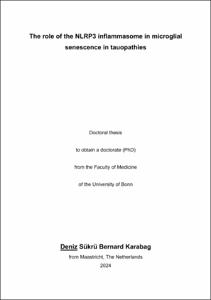The role of the NLRP3 inflammasome in microglial senescence in tauopathies

The role of the NLRP3 inflammasome in microglial senescence in tauopathies

| dc.contributor.advisor | Heneka, Michael | |
| dc.contributor.author | Karabag, Deniz | |
| dc.date.accessioned | 2024-03-12T16:49:02Z | |
| dc.date.available | 2024-03-12T16:49:02Z | |
| dc.date.issued | 12.03.2024 | |
| dc.identifier.uri | https://hdl.handle.net/20.500.11811/11424 | |
| dc.description.abstract | Background: Tauopathies including Alzheimer’s Disease and Frontotemporal Dementia are neurodegenerative disorders characterized by abnormal tau accumulation. Senescent cells, which present with a potentially disease-modifying senescence-associated secretory profile (SASP), were shown to contribute to disease progression. While we recently showed that loss of microglial NLRP3 inflammasome function reduces tau accumulation, the role of microglial senescence and the contribution of the NLRP3 inflammasome in this context remain elusive.
Methods: Hippocampi from aged wildtype (WT), tau-transgenic Tau22, Nlrp3-knockouts (Nlrp3-/-) and Tau22/Nlrp3-/- mice were used for immunohistochemical or gene expression analysis of the senescence markers p16, Lamin B1 and yH2AX in microglia. In vitro, we established a primary microglial senescence model using human tau. Using this model and by applying various methods including immunocytochemistry, qRT-PCR and Western Blot, the contribution of the NLRP3 inflammasome was evaluated using pharmacological inhibition and knockout of NLRP3. Additionally, SASP factors were characterized by ELISA and Mesoscale. Results: Here, we demonstrate that microglia in Tau22 mice show increased levels of p16 and yH2AX and decreased levels of Lamin B1 and several SASP factors as compared to WT. NLRP3-deficiency normalized the expression of p16 and Lamin B1. In vitro, exposure to tau led to the induction of a senescent phenotype characterized by increased p16, p21 and yH2AX, decreased Lamin B1 and the release of various SASP factors, including IL-1b and IL-6. Inhibition of NLRP3 normalized p21 and Lamin B1 levels and ameliorated, but did not completely block the SASP in microglia in vitro. Interestingly, we found that the transcription factor STAT3 plays a key role in the remaining NLRP3-independent SASP release. Conclusions: In conclusion, we demonstrate that senescent microglia emerge in a tauopathy mouse model and that NLRP3-deficiency mitigates microglial senescence in vivo. Furthermore, using our microglial senescence model in culture, we found that the NLRP3 inflammasome is a mediator of tau-induced microglial senescence. Employing this model will be instrumental in the future to further explore the contribution of the NLRP3 inflammasome to microglial senescence in tauopathies in more detail. | en |
| dc.language.iso | eng | |
| dc.rights | In Copyright | |
| dc.rights.uri | http://rightsstatements.org/vocab/InC/1.0/ | |
| dc.subject.ddc | 610 Medizin, Gesundheit | |
| dc.title | The role of the NLRP3 inflammasome in microglial senescence in tauopathies | |
| dc.type | Dissertation oder Habilitation | |
| dc.publisher.name | Universitäts- und Landesbibliothek Bonn | |
| dc.publisher.location | Bonn | |
| dc.rights.accessRights | openAccess | |
| dc.identifier.urn | https://nbn-resolving.org/urn:nbn:de:hbz:5-75534 | |
| dc.relation.doi | https://doi.org/10.1111/jnc.15866 | |
| ulbbn.pubtype | Erstveröffentlichung | |
| ulbbnediss.affiliation.name | Rheinische Friedrich-Wilhelms-Universität Bonn | |
| ulbbnediss.affiliation.location | Bonn | |
| ulbbnediss.thesis.level | Dissertation | |
| ulbbnediss.dissID | 7553 | |
| ulbbnediss.date.accepted | 04.03.2024 | |
| ulbbnediss.institute | Medizinische Fakultät / Institute : Institut für Angeborene Immunität | |
| ulbbnediss.fakultaet | Medizinische Fakultät | |
| dc.contributor.coReferee | Korte, Martin | |
| ulbbnediss.contributor.orcid | https://orcid.org/0000-0001-8322-0751 |
Files in this item
This item appears in the following Collection(s)
-
E-Dissertationen (2059)




